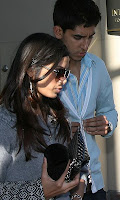 Secrets
Secrets (2007)
So I was introduced to this most delicious artist my friend N. gave me her website
http://www.chitraganesh.com/A New York native and resident
Chitra Ganesh finished her B.A. at Brown in 1996 and then completed her MFA at Columbia. A many faceted artist Ms. Ganesh examines South Asian culture as a first generation American using a variety of material in her multi-medium art work. Her website gives detailed examples of her installations, digital collages, photography, works on paper and painting.
In her artists statement Ms. Ganesh describes her digital collages as “inspired by images from Indian comic books known as Amar Chitra Kathas” which are educationally based, comic book format stories from Indian epics, mythology, history, folklore, and fables. By North American standards Amar Chitra Kathas fall short of their goal to relay a historical narrative while providing a moral bases for “models of citizenship, nationalism, religious expression, public behavior, and sexuality”. Ms Ganesh shakes things up drastically “by integrating fragments of the original comics with pen and ink drawings and rewriting the text.” Her words simultaneously compliment and contrast the images, drawing attention to the multitude of South Asian cultural stories from the past and present. The image of the female, juxtaposed as the 'dynamic sexual character' yet dismembered and bloody, further ministers to the unanswered questions of the viewer.

Tantamount to the reoccurring themes in her digital collages are those found in Ms. Ganesh’s paintings. As poignantly as in her other works, the role of the female is glamorized in the spirit of Bollywood fame and then dredged with dejection. Again we see the theme of fragmented parts, in
Salome (2000, acrylic on fabric) myth is encapsulated with colonialist era subservience, sexuality and the ultimate virtuousness of the side of head. In
Zeenat On The Board (2007, acrylic and ink
on carrom board) a regal image of a woman is shown in contemporary beachwear holding a dual structured skull. Carrom is a popular game said to have originated in India. The object of the game is to flick, with a finger, a disk know as a ‘striker’ and to strike another lighter disk, propelling it into one of four corners. In carrom as in Ms. Ganesh’s painting the red or pink ‘Queen’ is the most powerful carrom piece and is placed in the center of the circle. To win the game one must pocket their opponents Queen thus metaphorically owning her.

The installations that are shown in New York, Houston, Saskatchewan and Vitoria-Gasteizare are testaments to Ms. Ganesh’s ability to create texture, sculpture, space, value, movement, emphasis and balance within the constraints of white walls and nature alike. Having obtained a MFA in writing Ms. Ganesh often uses words as part of her installations, as in her digital collages. In Hair Poem (2007, mixed media including hair, wire, oil and glass) the ancient act of shaving one’s head as an offering to Hindu gods is analogous with the contemporary phenomenon of Indian woman’s hair being sold to supply the North American trend of purchasing hair extensions. In Altered (2001, mixed media installation) everyday office objects are placed in a circular, rhythmic pattern placing emphasis on the two pictures mounted on the wall and the religious figurines at its core.
Ms Ganesh certainly succeeds in creating stratified works each its own unique sordid tale. In consideration of her art one is taken through a process of shedding layers of one’s own life experiences, applying them (or not) in whatever relevance, to women in South Asian culture.
Ramp Drawing 
(2005)mixed media installation created for Fatal Love, Queens Museum of Art, NY
(http://www.amarchitrakatha.com/main/index.php)



















